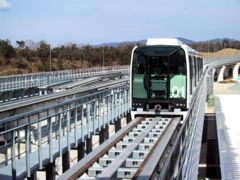Linimo
Linimo (リニモ Rinimo?), formally the Aichi High-Speed Transit Tobu Kyuryo Line (愛知高速交通東部丘陵線 Aichi Kōsoku Kōtsū Tōbu Kyūryō-sen?) is a magnetic levitation train line in Aichi, Japan, near the city of Nagoya. While primarily built to serve the Expo 2005 fair site, the line is still operating to serve the local community. Linimo is owned and operated by Aichi Rapid Transit Co., Ltd. (愛知高速交通株式会社 Aichi Kōsoku Kōtsū Kabushiki Gaisha?).
Linimo claims to be the world's first commercial automated "Urban Maglev". The linear motor magnetic-levitated train has a top speed of 100 km/h, floating eight millimeters above the track when in motion, and is intended as an alternative to conventional metro systems, not high-speed operation. The line has nine stations and is 8.9 km long, with a minimum operating radius of 75 m and a maximum gradient of 6%. The trains were designed by the Chubu HSST Development Corporation, which also operates a test track in Nagoya. Construction of the track cost ¥60 billion (US$575 million) while the Linimo trains themselves, built by Nippon Sharyo, cost ¥40.5 billion (US$380 million). [1] The overall construction cost thus came to roughly $100 million/km.
Being the first commercial implementation of a new type of transport system, the line suffered a number of highly publicized technical breakdowns during the Expo, with far higher demand during peak hours than the line's carrying capacity of 4000 passengers/direction/hour. On March 19, 2005 and again on March 24, the number of people inside the trains exceeded the design capacity of 244 passengers/train and the train was unable to levitate. The line also has to be shut down for safety reasons when wind speed exceeds 25 m/s, a relatively common occurrence in the area.
History
- October 3, 2001 — Permission to build the line granted
- March 6, 2005 — Line opened to the public
- July 3, 2005 — Ten millionth passenger
- April 1, 2006 — Stations L07 and L09 renamed
Stations
- Fujigaoka Station (L01) — interchange to Nagoya Subway Higashiyama Line
- Hanamizuki-dori Station (L02)
- Irigaike-koen Station (L03)
- Nagakute-kosenjo Station (L04)
- Geidai-dori Station (L05)
- Koen-nishi Station (L06)
- Aichikyuhaku-kinen-koen Station ("Expo Memorial Park") (L07), formerly Banpaku-kaijo Station ("Expo Site")
- Toji-shiryokan-minami Station (L08)
- Yakusa Station (L09), formerly Banpaku-Yakusa Station — interchange to Aichi Loop Line

